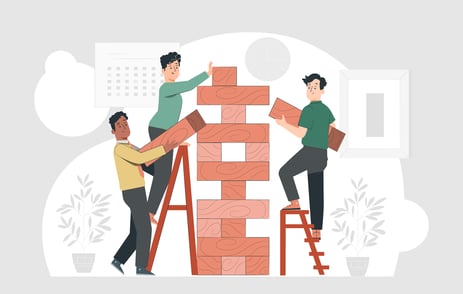In today's rapidly evolving world, your association’s members have access to an ever-broadening array of resources and knowledge outside of your association’s library. This shift underlines the urgency with which associations must adapt to stay competitive and continue delivering value to their members.
The rise of artificial intelligence (AI) has opened up new opportunities for associations to leverage their unique strengths and create a strategic moat that sets them apart from potential competitors, including competitors in the for-profit space. In this blog post, we will explore the concept of a strategic moat, discuss how associations can strengthen their moat, and examine the role of AI in this process.
And don’t worry. You don’t need crocodiles to make this moat successful.
What is a Strategic Moat?
Associations often overlook the importance of having a strategic moat, which is a competitive advantage that provides long-term durability in the market. A strategic moat acts as a barrier to entry for competitors and ensures that associations can maintain their position in the industry. While AI itself may not be a candidate for a strategic moat, associations possess three key elements that can contribute to their moat:
1. Brand Reputation: As not-for-profit organizations, associations hold a unique position as arbiters of truth and objectivity in their respective industries. This brand reputation instills trust in members and creates a distinct advantage that is difficult for newcomers to replicate.
2. Rich Content: Associations have a wealth of trustworthy and relevant content that can be used to train AI algorithms. By leveraging AI, associations can enhance the creation, personalization, and delivery of their content, which in turn enhances member engagement and satisfaction.
3. Professional Network: Associations typically have deep relationships with key influencers within their industry. This network enables them to access valuable insights, expertise, and collaboration opportunities that can enrich their offerings and expand their influence.
How to Use the Flywheel Effect to Support a Strategic Moat
To fully leverage their unique strengths and build a strategic moat, associations can adopt the concept of a flywheel. This flywheel, popularized by Jim Collins in his book "Good to Great," represents a cycle where each step feeds into the next, creating a virtuous cycle of momentum and growth. For associations, this flywheel is driven by three components:
1. Producing Better Content: Associations can harness their professional network to create high-quality and relevant content. AI can augment the content creation process by providing more targeted information, identifying new areas of focus, and making content more engaging and accessible for members on a daily basis.
2. Deepening Relationships: By providing valuable content, associations can attract professionals and deepen their relationships with members. AI can help personalize communications, understand member preferences, and facilitate meaningful interactions that strengthen these relationships further.
3. Increasing Brand Reputation: As associations produce better content and deepen relationships, their brand reputation naturally grows. Member satisfaction and word-of-mouth referrals contribute to an association's brand strength, making it a trusted authority in the industry.
The Role of AI in Strengthening the Strategic Moat
AI serves as a catalyst in the flywheel, accelerating each component and maximizing the benefits associations can derive from their unique strengths. By leveraging AI, associations can:
1. Improve Content Creation: AI algorithms can analyze vast amounts of data to identify trends, patterns, and insights. This information can guide associations in producing more targeted and relevant content, ensuring they deliver exceptional value to their members.
2. Personalize Member Experiences: AI can help associations personalize their communications and interactions with members. By understanding individual preferences and behaviors, AI-powered systems can deliver tailored content and recommendations, increasing member engagement and satisfaction.
3. Identify Growth Opportunities: AI technology can analyze market data, identify emerging trends, and uncover new growth opportunities. Associations can use this knowledge to adapt their offerings, expand into new areas, or create innovative services that meet the changing needs of their members.
4 Steps to Strengthening (or Building) Your Strategic Moat
Considering the potential competition and the need to differentiate your organization, you can take several steps to solidify the association's strategic moat:
1. Evaluate the Current Moat: Convene your team and assess the unique strengths of your association that differentiate it from potential competitors. By understanding the current moat (or the lack of one), they can identify areas for improvement and determine the best course of action.
2. Embrace AI: Integrate AI into your operations, leveraging its capabilities to enhance content creation, personalize member experiences, and identify growth opportunities. This will accelerate the flywheel effect and strengthen the association's strategic moat.
3. Foster Collaboration: Nurture relationships within your professional network. Collaborating with industry influencers and thought leaders will not only enhance your content but also reinforce your association’s brand reputation.
4. Continuously Innovate: To remain ahead of potential competitors, encourage your team to embrace a culture of innovation. By exploring new technologies, experimenting with AI applications, and staying at the forefront of industry trends, you can maintain your position as a leading association.
Differentiation is Key to Longevity
In the age of AI, associations must leverage their unique strengths to build a strategic moat that sets them apart from competitors. By combining their brand reputation, rich content, and professional network with AI capabilities, associations can create a flywheel effect that drives sustained growth and success. Associations can embrace AI to improve content creation, personalize member experiences, and identify growth opportunities. To stay ahead of the competition, it is crucial for associations to continuously innovate and adapt to the changing needs of their members. To learn more about unlocking the power of AI for associations and connect with other association leaders, download our free ebook, "Ascend: Unlocking the Power of AI for Associations."

Tags:
Artificial Intelligence
July 20, 2023


